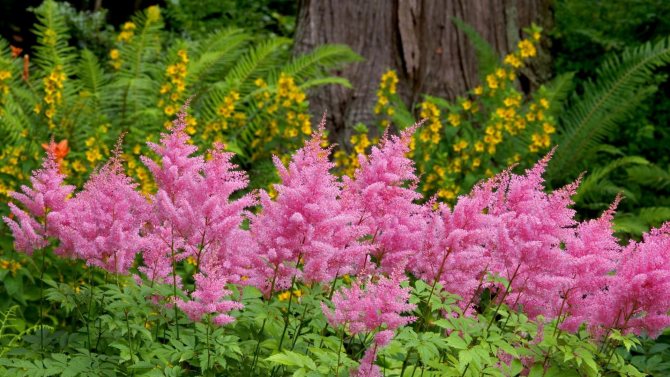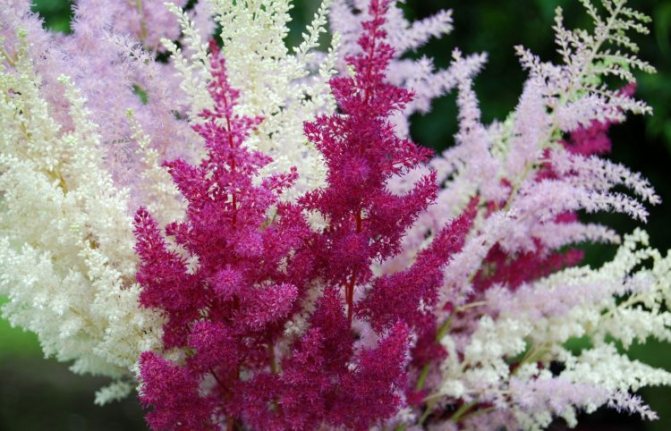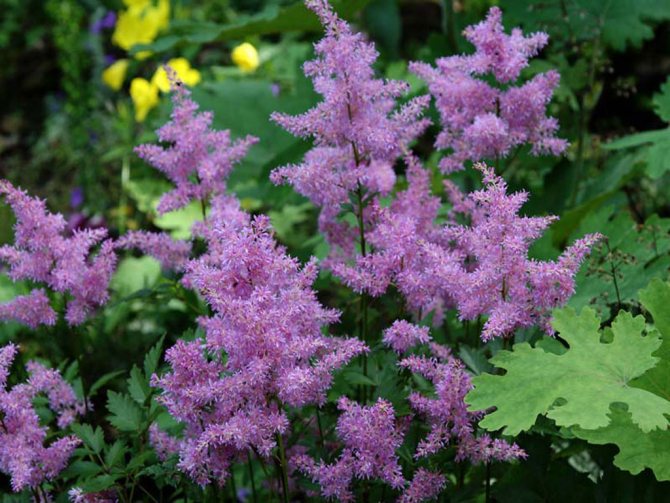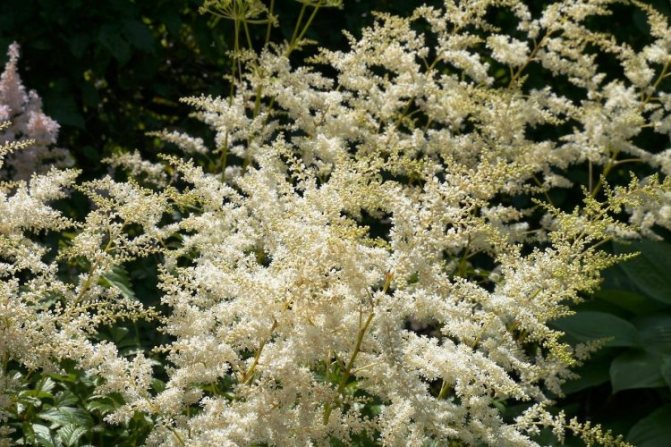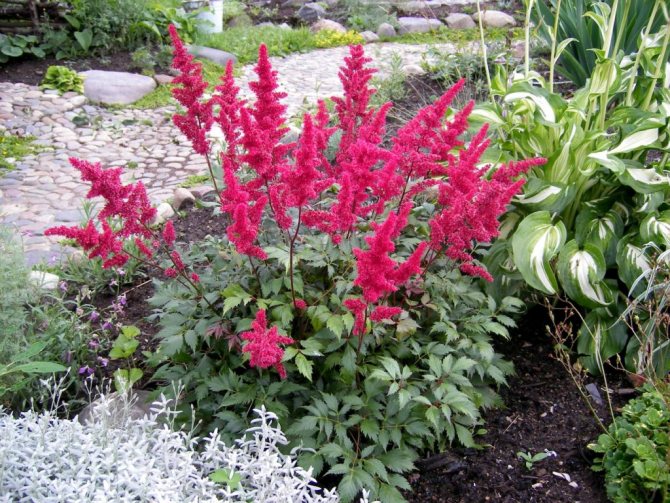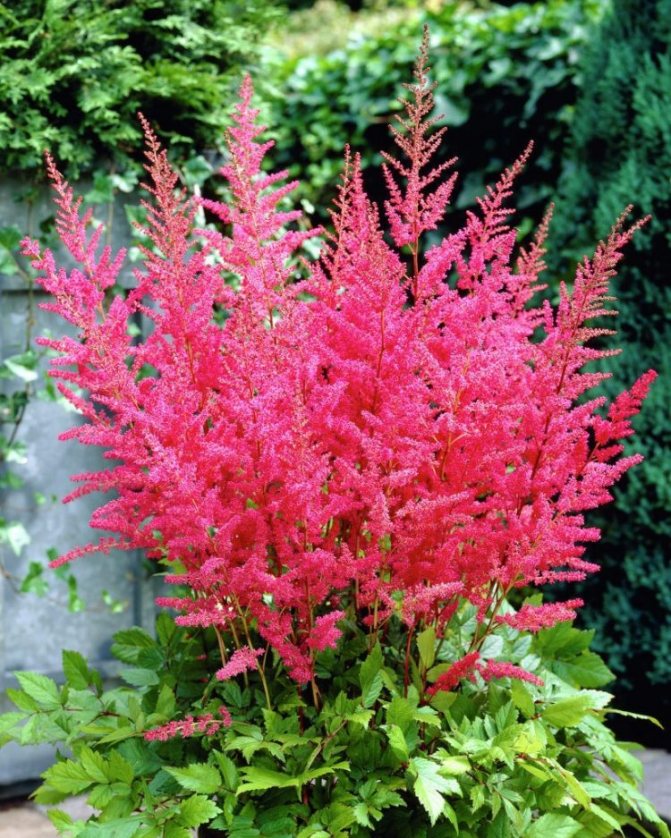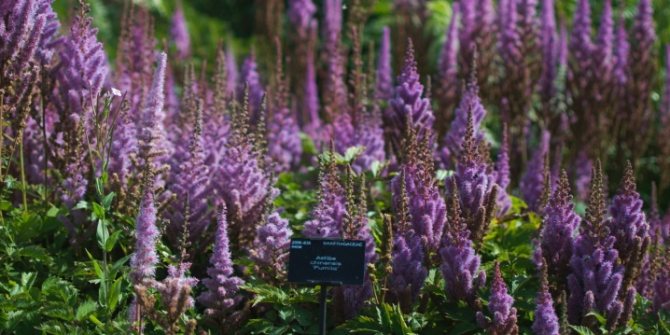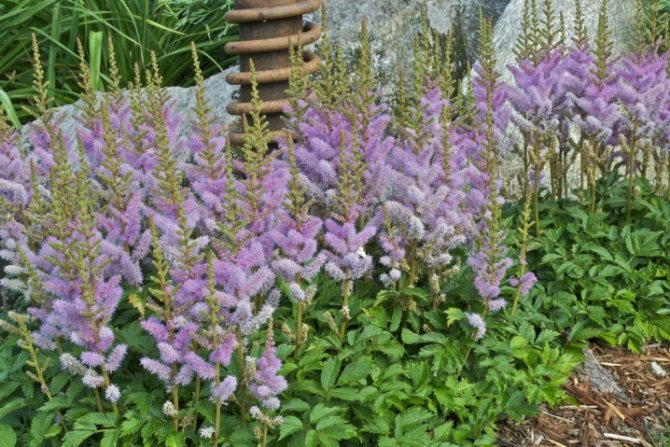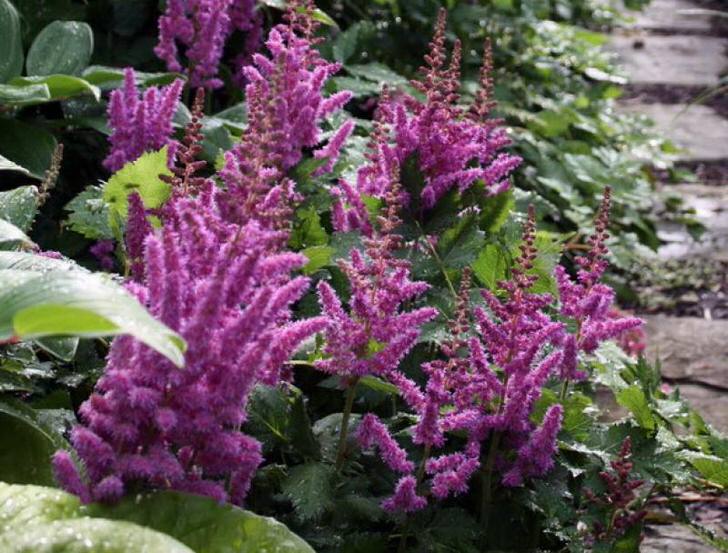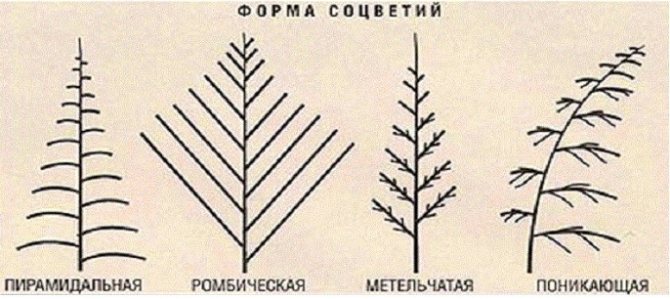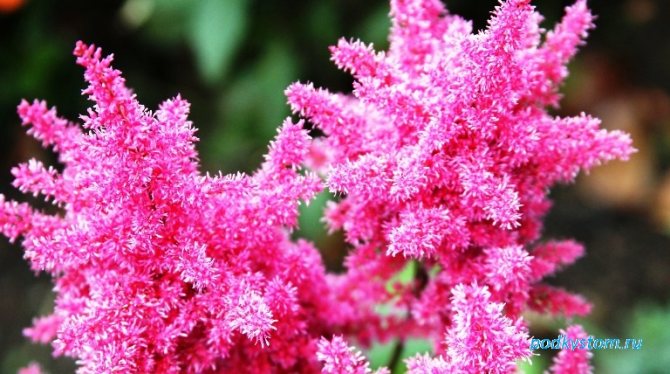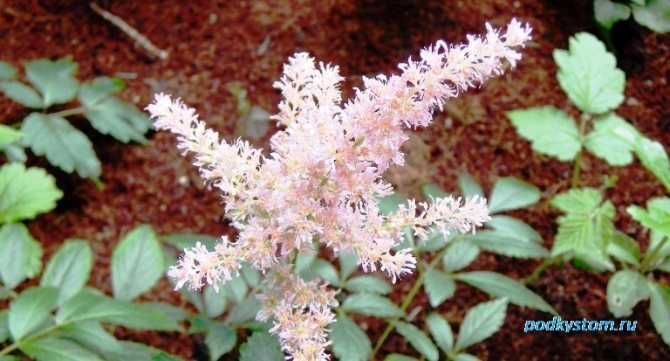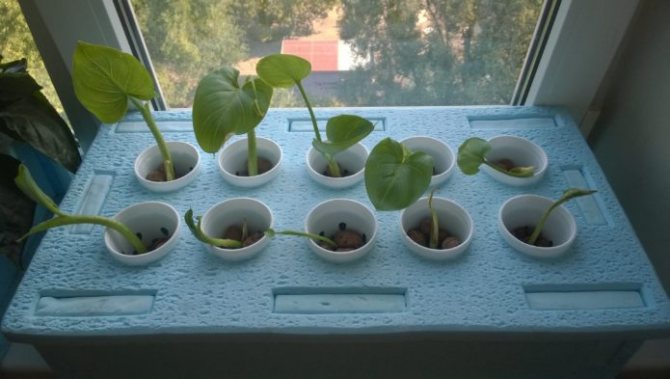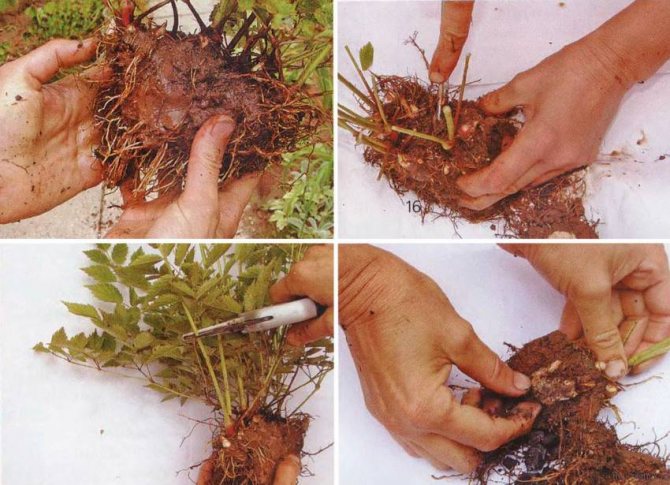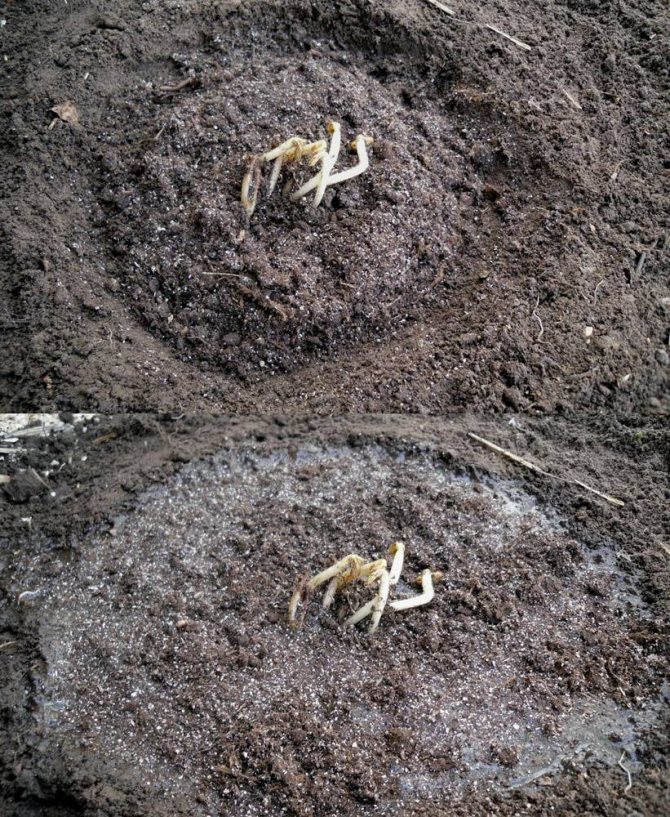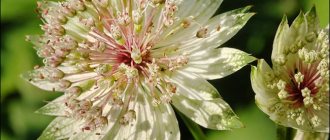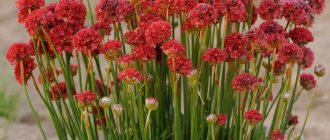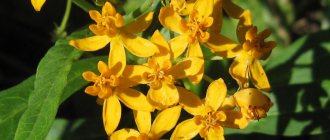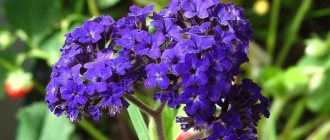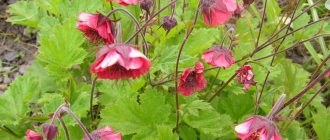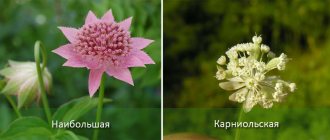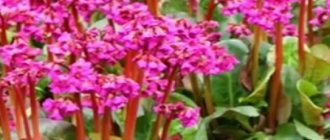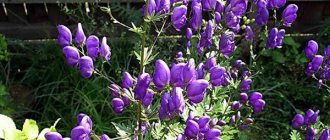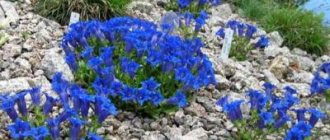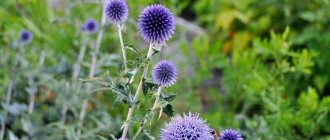Astilba, due to its unpretentiousness, is often called a plant for beginners. It does not lose its decorative effect when grown in one place for up to 10 years, it is resistant to cold weather, diseases and pests. But, most importantly, she is charming!
Astilba is a herbaceous perennial from the saxifrage family, its homeland is China and Japan. Several varieties are grown in the gardens. From a large number of different varieties, you can pick up plants that bloom almost from the beginning of summer to November. The earliest of all is Japanese Astilba. It grows in low bushes 60-70 cm high with openwork glossy leaves with reddish or brown veins. Paniculate inflorescences are formed by small, pink flowers, with a faint aroma, vaguely similar to hydrangea.
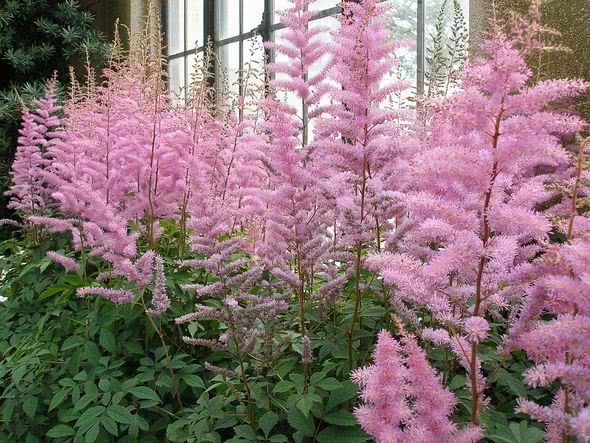
The color of astilba inflorescences is varied - from white, cream, pink, bluish to red and purple. Plant varieties, in addition to the color of the inflorescences, differ in their shape and density, as well as the color of the leaves and ripening times. Looks very good in group plantings near shrubs, in the shade of tall trees or walls. Astilba panicles are used for cutting and dry bouquets.
Thunberg hybrids (A. Thunbergii Hybrida)
Thanks to this type of astilba, numerous hybrids and varieties were born, which have been popular among amateur flower growers for many years.
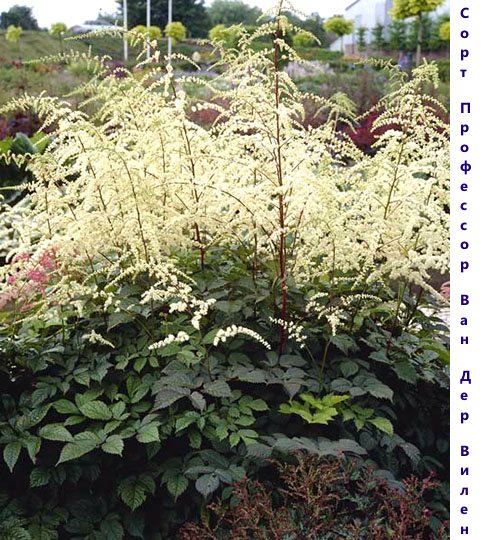

Astilbe Professor Van der Wielen with milky white flowers on thin reddish-brown stems is receiving active attention. The height of this variety reaches 90–150 cm. The length of racemose inflorescences up to 45 cm long - to match the size of the bush. Flowering time begins in July.


The bright bloom of astilbe Straussenfeder attracts the eye not only with the graceful shape and size of the inflorescences, but, first of all, with their unusual coral coloration. Plants of the Straussenfeder variety grow up to 80–100 cm, bloom at the end of July and will greatly decorate shady areas of the garden and corners under the diffused sun.


Another variety of Thunberg's astilba, Red Charm, strikes with a rich raspberry-purple hue of flowers and a brownish color of young foliage. A place for such a bright variety will be found in the center of a spacious flower garden or under the crowns of trees, where astilbe Red Charm will not be annoyed by direct sunlight.
Types and features
The unpretentiousness of the plant is characterized by the presence of a branched root system. Around the world, botanists have counted more than 200 varieties of astilba. All varieties are divided into 4 groups:
- Dwarf species grow up to 30 cm.
- Low-growing varieties grow up to 60 cm.
- A medium-sized variety can reach 90 cm.
- Tall astilbe reaches 2 meters.
There are many wild varieties among the varieties. Wild varieties grow in forests, along river banks, and where moisture is present.
Variants of compositions with astilba
Astilbe in garden landscaping is very often used to highlight dark shady areas. This flower also serves as a decoration for unsightly places and artificial ponds. One of the popular options for compositions with astilba is a black and white flower garden. To create a monochrome flower bed, you need to plant the seeds of such plants:
- white Siberian irises;
- variegated iris;
- white dotted bells;
- triangular or carob sour, which has purple-black foliage;
- astilbe varieties Deutschland.
Hydrangeas in landscape design
It is worth considering that the perennial astilba loves moisture, therefore it is recommended to plant it on the shore of a pond or an artificial lake, as well as nearby water columns that are located on the site. Near water bodies, the culture will bloom much longer, and when creating a spectacular composition, it is necessary to plant such plants as European hoof, Astilbe called Arends, dioecious volzhanka, host Siebold and a hybrid daylily.
Important! When choosing astilbes for your summer cottage, you must definitely pay attention to what colors the foliage has. Color Flash has bright red leaves, and Queen of Holland has cherry leaves, so it is recommended to plant them in the foreground.
Diseases and pests
An amazing plant. Strong immunity to frost, blooms in many colors for a long time. There is one more plus - pests do not like this culture. Minor exceptions do occur. Snails or aphids appeared on the bush - spray with insecticides or diluted laundry soap. The root is affected by the rootworm nematode - to destroy the infected bush, the fight against this pest is useless. Treat the soil around the removed shrub, do not use the planting site for a long time. The stump on the foliage is harvested by hand to avoid mucus growth
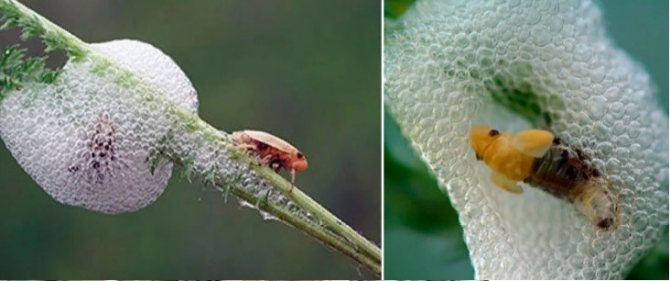

In the photo, the penny is slobbering
Astilba: briefly about the flower
The bush has long, narrow leaves on tall stems with a green or reddish-green color. The length of the stems depends on the type and variety, ranging from 8 to 200 cm. In the cold season, the aerial part dies off, and the powerful rhizome remains overwintering. Small flowers are collected in inflorescences of different colors: pink, lilac, red, white. Bloom in summer in June, has a capsule-fruit.
Shade-loving Astilbe loves frequent watering and fertile, moist soil. It needs constant renewal of the soil, so periodically you need to add fertile soil with mulching near the roots. Propagated by dividing the bush and in rare cases by seeds. Planting is done in May, and transplanting can be done in any season.
To prevent the bush from wilting, not fading, it requires regular abundant watering. You should also monitor the condition of the soil, which should be fertile and moist.
A light shade is exactly what an astilbe needs. She does not need direct sunlight, and gives long flowering in a thin shade.
In the fall, a dried bush should be prepared for cold weather. After cutting off the stems, the remaining roots must be covered with layers of natural material, for example, ordinary leaves.
Plant care
Watering
It is necessary to monitor the level of soil moisture. The intensity of watering depends on the frequency of precipitation. When they fall out, watering is reduced. In the heat, the plant is watered twice a day.
Before watering, it is advisable to loosen the soil and remove weeds - this will help absorb moisture and nutrients. Bushes must be hilled.
Top dressing
Fertilizer is applied 3 times per season:
- in the spring after the snow melts;
- in June;
- after flowering.
For spring feeding, nitrogenous fertilizer is best suited. It stimulates the growth of new shoots well. During hilling, rotted compost is introduced into the soil. Of the mineral supplements, it will be useful to use ammonium nitrate or urea. To do this, it is enough to dissolve 20 g of the substance in 10 liters of water.


Before planting, the soil is fertilized
The second feeding is done using saltpeter. You need to take 2 tbsp for a bucket of water. l. fertilizers. The last feeding is carried out with superphosphate. 30 g of the substance is applied by irrigation or directly into the soil.
Transfer
Although rare, there are cases when astilba needs a transplant.After a while, the roots can crawl out to the surface and dry out. This causes the plant to dry out or poor flowering. The number and size of inflorescences decrease.
If the plant looks worse and has not been transplanted for a long time, you can update its appearance with a transplant.
On a note! The transplant can be replaced by regular soil renewal. It is enough to add fresh soil mixture, including fertilizers.
Autumn works
Since astilba flowers retain their beauty for a long time, they are not cut off in the fall, but left in a semi-dry form until winter. In order to prepare for wintering, the stems are cut under the root.
Shrub trimmings are sprinkled with dry leaves or covered with spruce branches. If there is a lot of snow in your area, then it is not necessary to cover the astilbe. The plant is able to withstand frosts down to -30 ° C.
Origin story
Astilba remained underestimated for a long time and was relatively recently introduced into culture. The plant was first described by Lord Hamilton in 1825. The wild-growing riverine astilbe did not differ in outstanding appearance, the leaves and inflorescences were without shine and gloss, which was mentioned in the description ("a" - without, "stilbe" - shine). However, a few specimens were brought by Hamilton to Europe and cultivated as a cut crop.
The potential of the flower was one of the first to be seen by the French botanist Emile Lemoine, who received a number of varieties in the 90s of the XIX century. He paid special attention to the garden forms. Several dozen combs were bred by the Dutch breeder V. Reis and a number of other scientists.
However, the greatest contribution to the selection and breeding of astilbe belongs to Georg Arends, who devoted 54 years of his life to this plant. During this time, he managed to get 84 varieties that differed in flowering time, shape and color of inflorescences, shape and size of the bush. He was the first to lay the foundations for the classification of cultivated forms and varieties of astilbe. Unfortunately, after the death of the researcher, the plants were practically forgotten. Only in the 60s, interest in astilbe reappeared, and culture began to revive thanks to the efforts of Dutch and Latvian scientists. The Lemoine and Arends varieties have become real classics and are still popular today.
Brief cultural background
Astilba chinensis is a perennial herb that is often used in landscaping for its spectacular-looking, brightly colored paniculate inflorescences. The plant belongs to the genus Astilba and belongs to the saxifrage family. Astilbe grows wild in the following regions:
- China;
- Japan;
- North and South Korea;
- Far East of the Russian Federation (Primorsky Territory).


Chinese astilba
In Russia, this flower appeared relatively recently, at the end of the twentieth century. First, astilbe came to Europe, and from Europe (specifically from Holland) to Russia. Domestic breeders have bred several varieties, zoned for the Russian Central Lane and more northern regions.
Attention! This flower grows especially well in a climate similar to that of China.
The flower is an excellent honey plant and is very popular with the owners of private beekeeping farms. Also, this plant is used as an ornamental plant. In this regard, the most spectacular is the Chinese astilba Vision in ed. Astilba roots, stems and inflorescences contain natural antioxidants and bioflavonoids, and are also rich in vitamins.
In China, some varieties of this plant have been used since ancient times in folk medicine, as well as in cooking: as a seasoning for fish and meat dishes. In Russia, medicinal raw materials from astilba are also sometimes used by doctors practicing alternative medicine.
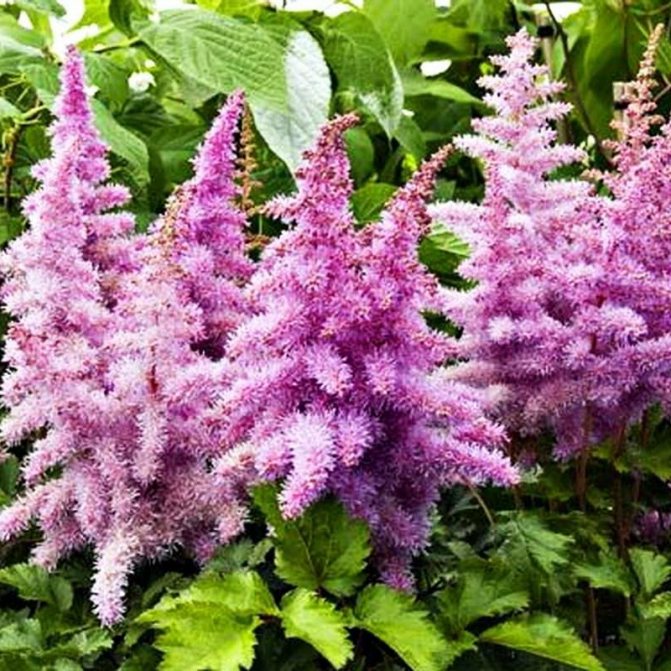

Chinese astilba
Description of the plant
The astilbe flower is a perennial plant of the Saxifragaceae family.In its natural environment, it is found in North America and Asia. Astilba in the Land of the Rising Sun is highly respected. It is part of the elegant floral arrangements that form an important part of the traditional tea-drinking ceremony.
In the gardens, there are hybrids formed from the crossing of varieties - Astilbe astiboides, Astilbe japonica, Astilbe thunbergii with the species Astilbe chinensis. Plants reach a height of 50-150 cm, have straight, rigid stems and double feathery leaves, with serrated edges, wrinkled leaf blades, pubescent. Due to its beautiful, feathery leaves, located on rigid petioles and forming dense clusters, astilba is decorative all season - from spring to late autumn.
Astilba's most spectacular adornment is the extremely decorative, tiny flowers gathered on top of a lofty, rigid stem in gorgeous, paniculate inflorescences reminiscent of colorful feathers.
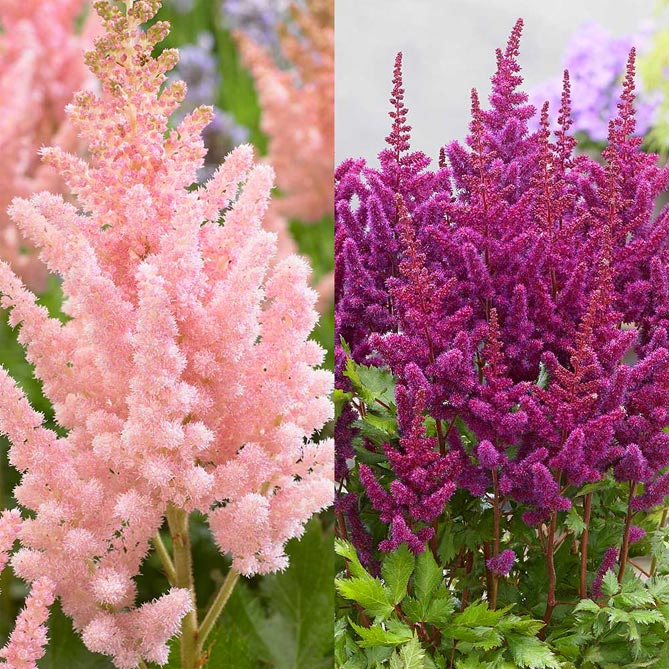

Flowers appear in summer - from July to September, depending on the variety. By flowering time, varieties are divided into early, mid-early and late.
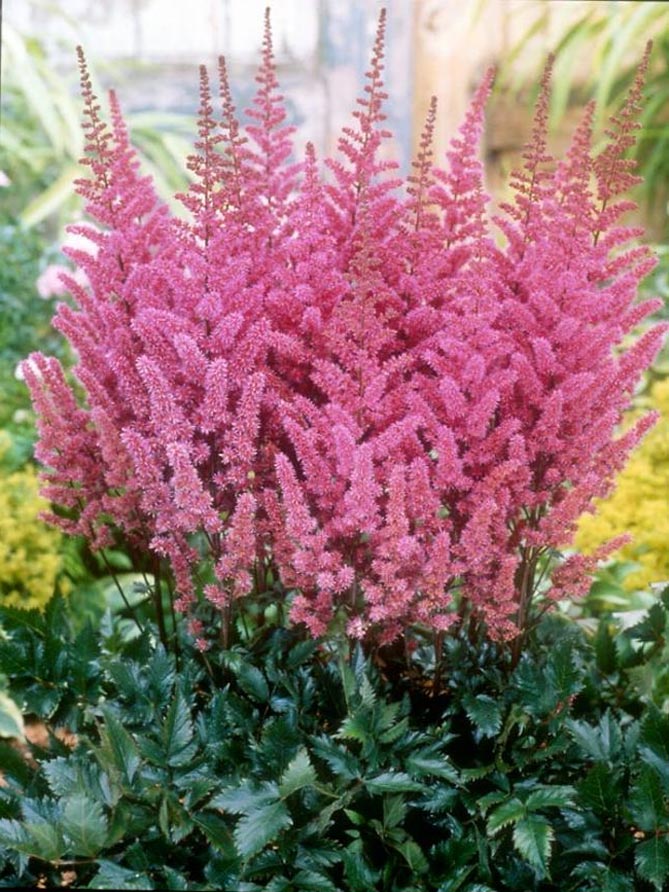

How to plant and care for astilba outdoors in Siberia and the Urals
Friends, I often see the question of how to grow astilba in open ground in Siberia or the Urals. I would like to note that the Urals are divided into 5 parts, from the southern to the polar, while Siberia stretches from the borders with Mongolia to the Arctic Ocean. To say how you can grow a plant in such an area is to say nothing. Yes, what is there, the Urals or Siberia, in our city where I live, in winter the temperature in different parts differs by 10 or more degrees.
It is always necessary to focus on your climatic conditions in your region. Sometimes there is one section located on the northern slope of the mountain, where cold winds often blow, and another from the southern slope, where there are no winds. These areas will have different conditions for plant care.
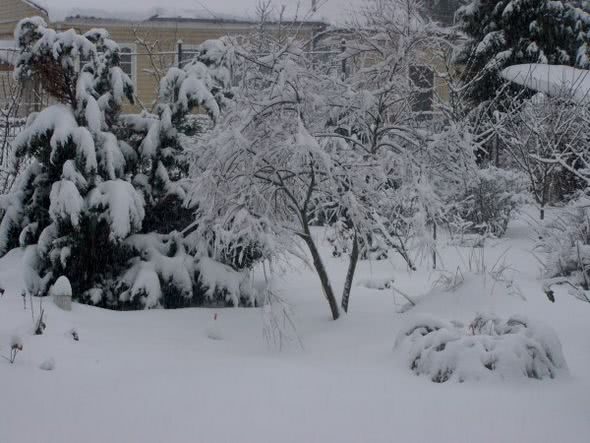

Therefore, just adhere to the rules of caring for astilba that I described above and proceed based on the local conditions of keeping your pets. And everything will work out!
That's all for me. I hope you have found information on caring for a very beautiful plant, and it will delight you with its beauty. Until next time.
Sincerely, Alexander.
Astilba breeding methods
There are 3 ways of reproduction of astilba: by dividing the bush, by renewal buds or by seeds.Dividing the bush - the most common and familiar way:
- The bush is dug up and, having cut off the leaves, cut it into pieces, including 3-5 buds.
- The dead rhizome is removed.
- Plants are planted at a distance of 30 cm from each other, watered every day.
The division is best done in early March - by the fall, the astilbe will already bloom.
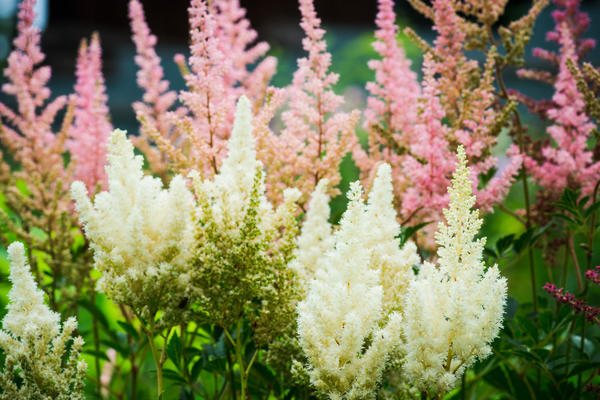

By autumn, astilba will already bloom
Renal reproduction renewal considered the faster way.
- In the spring, during the period of regrowth of shoots, or buds of renewal, they are carefully cut off with a piece of rhizome.
- Slices on the cuttings and plants are sprinkled with ash.
- The shoots are planted in a mixture of peat and gravel (3: 1) and covered with plastic wrap.
- Astilba is planted on a permanent "place of residence" in the fall or spring of the next year.
Varietal astilbe do not reproduce with the help of seeds. , since hybrid samples do not retain the characteristic features of the variety. Plants obtained in this way are used only in breeding. Nevertheless, when buying high-quality varietal seeds, it is quite possible to grow astilba:
- Seeds are sown in the soil pre-moistened with a spray gun, without embedding in the ground.
- To accelerate growth, stratification is carried out - a special method of seed preparation. For this, the seeds are placed in a cold place (with a temperature of -4 ° C to + 4 ° C), and after 20 days they are transferred to a bright, warm room (+ 18 ... + 22 ° C).
- In spring, delicate leaves can be safely planted in shaded beds.
Landing
Before planting, the soil is dug up, weeds and roots are removed, fertilized with a mixture of manure, peat and compost. The calculation is for 1 square meter of land 2 kg of organic mixture. Good flowering of astilba provides planting with other flowers. Fern, Siberian iris, badan, hosts, geychera, geranium, tiarella and bells go well. Also, joint flowering is provided by doronicum, gravilat, iberis and swimsuit, tenacious, crumble, umbilical and saxifrage.
A flower is planted towards the end of May.
Planting recommendations:
- A distance of up to 40 cm must be observed between each bush.
- A hole is dug with a width and depth of 30 cm.
- At the bottom of the pit, you need to fill in bone meal, a little humus and a complex fertilizer mixture.
- The soil is poured over the fertilizer and the root of the plant is planted.
- If the soil is dry, then it is imperative to water it with water before planting.
- The planting depth of the roots is about 20 cm.
Growing astilba from seeds


Astilbe can be propagated with the help of seeds, as well as divide the bush or separate the rhizome from the bud. Florists with little experience most often resort to vegetative propagation methods. However, only the seed propagation method allows the creation of new varieties. Seeds are sown in March. For planting, you will need a wide container, which should be 15 centimeters high. It is filled with a mixture of sand and peat, taken in equal parts. A layer of snow of a centimeter thickness is poured over the soil. In the event that there is no snow on the street, you can collect it in the freezer of your refrigerator. Seeds are distributed directly over the surface of the snow, which melts, carries them deep into the substrate. Further, the seeds will need to be stratified. To do this, when the snow has completely melted, the container must be placed in a bag, which should be transparent, and then put on the refrigerator shelf. The container should stay there until the seedlings appear (about 3 weeks). Then the container is removed to a well-lit place with a temperature of 18 to 22 degrees. The plants must be watered very carefully, otherwise they will die. So, water should be poured exclusively at the root, or you can inject it from a syringe directly into the substrate. After the plants have 2 or 3 true leaf plates, they need to be planted in separate pots.
How to plant astilba seeds in spring for seedlings
One way to grow astilba is from seeds. The method is not complicated, but rarely used. The fact is that flowering, with this method of planting, begins at 3 years old and, most importantly, many parental signs are not transmitted through seeds when planting, as a result, you can get something completely different from what is painted on the package with seeds.
Sometimes plants appear with very similar characteristics to the parent, and sometimes similar to another variety. By the way, sometimes completely nondescript specimens grow up. In any case, if you are interested, experiment.
When to plant perennial astilba
The best time to plant seeds is February-March. In this case, the planted seeds will have time to grow and get stronger by June, and those transplanted into open ground will take root and get stronger for wintering. If you have purchased an already germinated sprout, then the best time for planting is the end of May, when return frosts will pass.
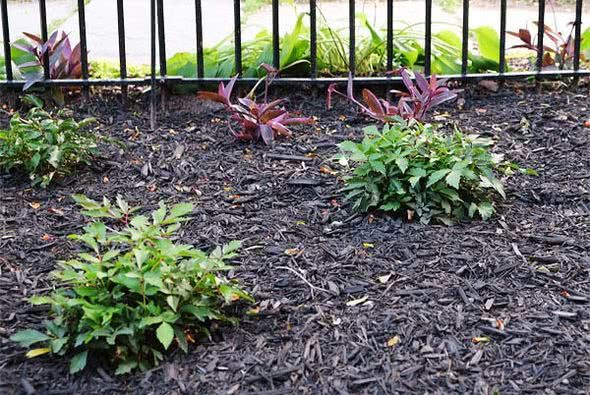

How to grow astilba from seeds at home for seedlings
If you nevertheless decided on this method of planting, then first prepare the soil. As I already wrote, astilba does not have any special requirements for the soil, so for planting you can take an ordinary earthen mixture, adding a little peat and sand to it for looseness. Pour it into a drawer and flatten it.


Before sowing, spill the soil well, let the water soak and then spread the seeds over the surface, without sprinkling anything. It is more convenient to do this with a slightly moistened toothpick, since they are very small. Then close the box with landings with glass or a bag.Now all your attention should be paid so that the earth does not dry out for an hour. Water carefully, along the edges of the box, the earth will saturate itself.
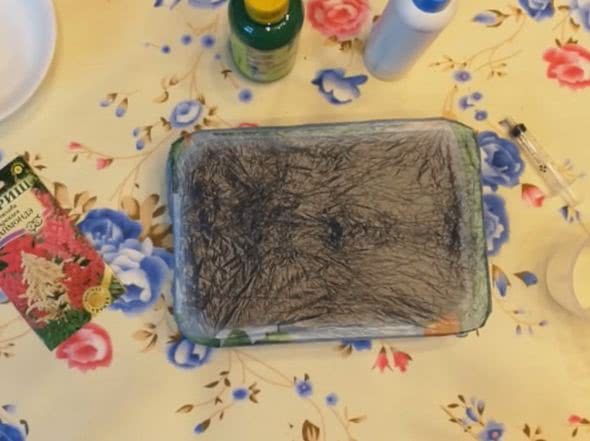

Maintain the temperature for germination at 18-22 degrees. Seed germination is very low, seedlings will appear in 3-4 weeks. If after 3 - 4 weeks seedlings have not appeared, it is recommended to carry out stratification, i.e. remove the box with seeds on the lower shelf of the refrigerator at 2-4 * C for another 2-4 weeks.
The hatched seeds are transplanted into pots and left in a bright place at a temperature of 18-20 * C. Grown plants are planted in open ground in May-June, when the risks of recurrent frosts have passed.
Astilbe flower - description
The astilbe flower is a herbaceous perennial plant in which terrestrial organs die off in the fall. The rhizome of astilba, depending on the variety, is loose or dense, the stem is erect, from 8 to 200 cm in height, the leaves are basal, long-petiolate, double or triple pinnate, sometimes simple, jagged at the edges, dark green or reddish green in color. Opening in June-July, small openwork flowers - pink, white, lilac, red, purple - form apical drooping, paniculate, pyramidal or rhombic inflorescences of various lengths. Astilba fruit is a capsule with many seeds.
Growing rules
The answer to the question of where to plant depends on the variety - in the shade, partial shade or on the sunny side? This is mainly a shade-loving grass, and only a few varieties tolerate the sun. The best option for breeding a moisture-loving culture is near water bodies. Engraftment, growth rate, flowering, depend on the correct selection of soil formation, soil preparation and the place of cultivation. The density of seating and the deepening of the fossa for planting are individual, depending on the grade.
Soil and site selection
The grower is puzzled by the questions, “Which transformation layer should I use? What place to choose for growing? " The unequivocal answer is in previously dug up and cleared soil from weeds, in shading, with the presence of groundwater. There are no special requirements for the quality of the soil. Sprinkle the increased acidity of the site with ash, wood or dolomite flour. Planting and care in an open, sunny place, not comfortable for the desired long flowering. Stagnant water and drought are contraindicated, so choose a place for astilbe growing on a hill. An excellent option is to land it near a pool, fountain, or natural reservoir.
Watering
The moisture content of the favorable land, an important answer to the question is astilba growing and nursing in the open field. The more sunlight falls on the flower, the more often it is to organize watering. The sputum of the substrate is a protection.
Top dressing and fertilization
It grows in one place for 5 years or longer. Keeps a healthy look, without transplanting and dividing the rhizome. It is necessary in the spring to carry out top dressing from complex nitrogen fertilizers, for the timely regrowth of new foliage. Apply humus to the soil near the bushes and huddle. At the time of flowering, fertilize with phosphorus, after discoloration, potash fertilizers are acceptable. After completing top dressing, mulch with a layer of peat, up to 5 cm thick.
Wintering
Winter frosts do not scare the culture, but prevention will be useful for flowering next season. The applied mulch on the surface will save from possible freezing. Shelter for wintering is not required.
Spring care
At the beginning of the onset of spring warming, clean the soil with a rake from the foliage left over from the previous season. The peculiarity of the culture is that buds appear on the upper part of the root in spring. During the time of gaining strength and growth, the buds form young rhizomes, which should not be on the surface. To do this, do not forget to sprinkle the bush with soil.
Astilba Thunberg (A. thunbergii)
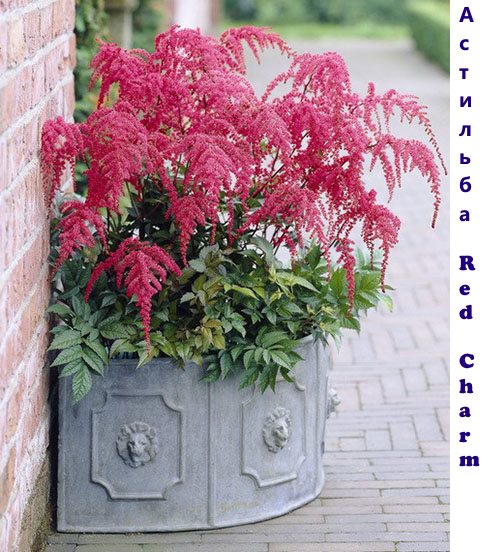

Although in nature astilbe Thunberg is found only in a small area from the Russian Kuril Islands to Japan, the plant has long been appreciated by botanists and lovers of ornamental crops. Wild specimens of this species do not exceed 80 cm in height, most of which fall on stems with apical inflorescences that appear in mid-summer. Sparse large panicles of 25 cm in length have a drooping shape, and white flowers emit a delicate light aroma.
For the first time, plants of this species were planted in the garden in the last quarter of the 19th century. Since then, Thunberg's astilba has been one of the favorites for many culture fans. The most naturally and effectively inclined inflorescences look in partial shade and near water, where Astilbees like to settle in nature.
Popular types
More than 30 varieties of crops have been bred by breeders. Varieties are divided into groups, classified by size, color and shape of inflorescences. The most resilient are tall.
Astilba David
The height reaches one and a half meters, spreading in forms. Foliage of a light green shade, twice and three times feathery in appearance. The flowers are small, pink, lilac. Inflorescences reach 40 cm. It blooms for an average of two weeks in mid-summer. The variety is unpretentious, care consists in timely watering, feeding with organic substances. The growing location is extremely shady.


Astilba nude
The variety is dwarf, height is not higher than 20 cm, in width it grows up to 15 cm. Frost-resistant, moisture-loving, not whimsical. Openwork leaves add splendor. Small flowers, collected in inflorescences, are pale pink in color. It is recommended to plant on stony soil near a reservoir, 2 - 3 pieces in one seat. Pleases until late autumn with a bronze tint of foliage.
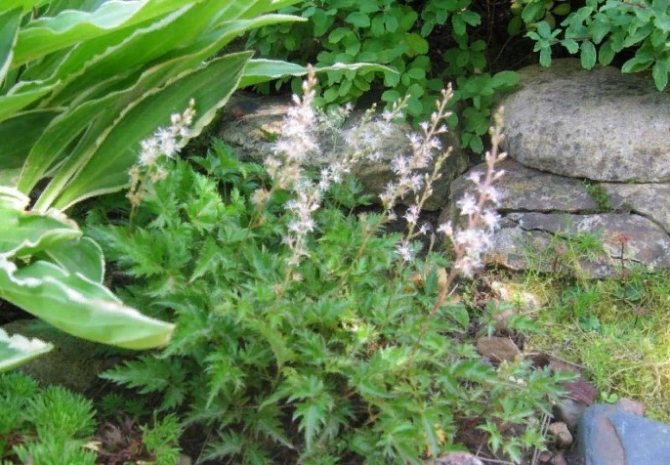

Chinese astilba
The stem is woody, solitary, with red hairs. Reaches one meter in height. The inflorescences are collected from red, purple or white flowers. The leaves are juicy green, delicate, covered with villi. Blooms throughout the summer. The peculiarity of the variety is that it has medicinal properties. It is used as an infusion and decoction from rhizomes and foliage. It is used for bruises, postoperative pain, rheumatism.
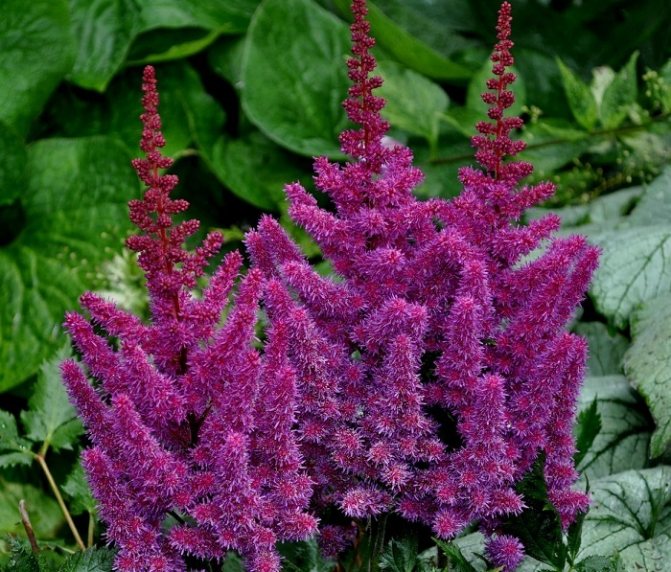

Japanese astilba
It grows widely, the height is within 70 cm. The leaves are pinnate and glossy, bright green in color. Flowers with aroma, white or pink. Inflorescences are diamond-shaped, about 30 cm, blooms at the peak of summer. When it blooms, the inflorescences will decorate the bush for a long time. A bouquet of dried flowers looks beautiful. Place preference - shade, watery soil. This elegant variety is frost-resistant, easy to take root after breeding.
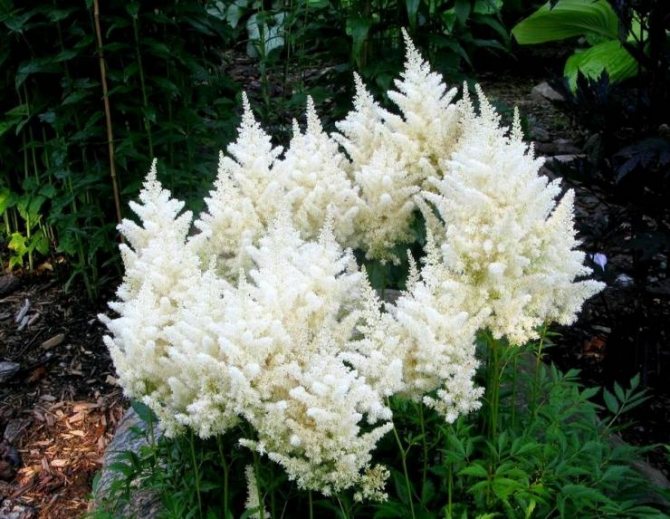

Astilba common
Shoots of medium length, about 45 cm, and the parameter is uniformly maintained in width and height. The leaves are carved, shiny, deep green. Inflorescences look white and pale pink lace. Drought-resistant, frost-resistant culture.


Astilba Arends
A large group of cultures, hybrid forms. Bred medium and high varieties. The root is powerful, cordlike. After reproduction by the method of dividing the rhizome, it quickly recovers. The palette of inflorescences is rich in color. Leaves are serrated, pinnate, green with shine. Blooms all summer. Frost resistant. The priority in choosing a place is partial shade, the soil should be watery.


Astilba Thunberg
An ornamental plant is represented by a compact bush up to 80 cm high. Leaves are formed over the entire surface of the shoots, have a pronounced serration. Flowering is usually observed in July, openwork racemose inflorescences grow up to 20 cm in length. This type of astilba is represented by a small number of varieties. The most popular ones are:
- Straussenfeder ... A Dutch variety, the plant prefers only wet places and is suitable for growing near a pond.The bush is dense and very decorative, the leaf blades have brown pubescence over the entire surface. Flowers form in July, collected in drooping coral-colored inflorescences. The variety is picky about growing conditions and care;
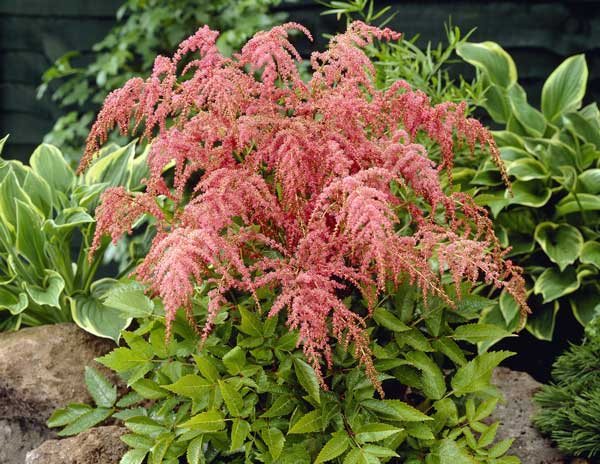

- Prof. van der Wielen ... Another variety developed by Dutch breeders. The bush up to 150 cm high retains its decorative effect throughout the summer. Leaves are dark green in color with small brown hairs. White flowers are collected in wide pyramidal inflorescences with small lateral branches. Flowering can last from July to August. Astilba of this variety is frost-resistant, no shelter is required for the winter.
Astilba Thunberg planting material can only be found in specialized nurseries. This type of culture is not widespread among gardeners; the plant can often be found in private collections.
Astilba care in autumn and preparation for winter
As I already wrote, astilba is an unpretentious plant with good frost resistance, and you may get the impression that you can do nothing in the fall. The opinion is not entirely correct, some actions still need to be done. This is especially true for first-year plants.


In order for a young bush to winter well, you should not let it bloom in the first year of life. Peduncles should be removed immediately, even before the formation of inflorescences. In this case, more nutrients will be used for the development of the root system.
The plant needs pruning. Pruning is usually done in two stages. The first time is pruned when the plant has faded. This is done so that the seed pods are not laid, otherwise they will take away some of the nutrients from the bush. If you cut them off, the plant is stronger and stronger for winter. At the same time, for the rest of the time, the lush green bush will continue to delight you with its beauty until autumn.
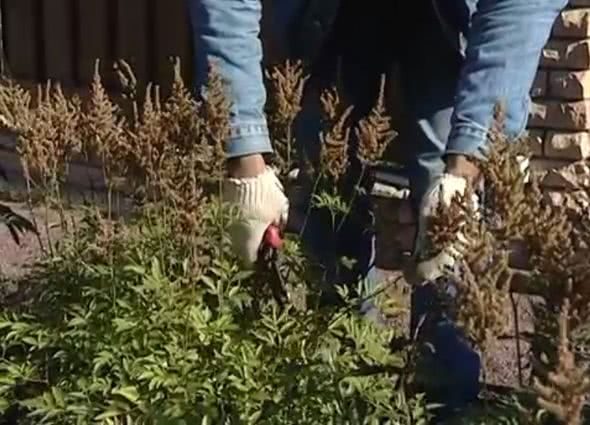

The second time, pruning is carried out already at the onset of frost. The entire upper part of the plant is cut to the very ground. Do not be afraid to cut off the excess, the upper part dies off in the fall and the plant begins to grow every year from the basal buds.
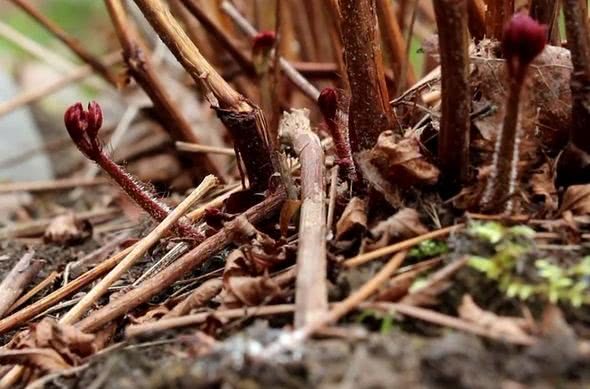

In the autumn, fertilizer should be applied under each bush. The main elements necessary for a plant after flowering are potassium and phosphorus. If you use dry vermicompost, then add 0.5 kg under each bush. In the case of using mineral fertilizers, add 1-2 tablespoons. complex fertilizer (about 30g per 1 sq.m.), previously dissolved in 10 liters of water.
As already mentioned, the root system of Astilba grows up over time and begins to climb out of the ground. Therefore, plants older than 5 years are subject to mandatory mulching of the trunk circle, and it is also advisable to cover the trimmed plant with non-woven material (lutrasil, spunbond) or coniferous spruce branches in order to protect the roots from freezing.
Thus, the list of works performed in the fall is reduced to the following operations:
- pruning
- feeding
- mulching and shelter for the winter
Autumn plant pruning
Friends, I want to share with you a video that tells and shows how to prune astilba in the fall, as well as what else needs to be done so that the plant overwinters well.
general information
The belated opening of buds in inflorescences is not the only difference between the Chinese group and adjacent species. This category abounds with tall plants, from 70 cm to 1.5 m. The bushes are usually spreading, growing rapidly, abundantly and long flowering. Dwarf varieties can be counted on one hand, as an exception to the rule.
For each of the crops, photos were selected, allowing you to consider in detail the main characteristics of the variety. After all, it is almost impossible to navigate the appearance of a plant on one verbal description.
The shape and color of the foliage is standard, characteristic of all types of astilbe. Leaves:
- complex;
- triple-separate;
- with gloss and matte;
- basal - large, on long petioles;
- stem - medium, on shortened petioles.
Large inflorescences (up to 35 cm) are endowed with the richest colors in the traditional white, red, purple tones. There are no blue, yellow, orange shades. Perennial is considered a good honey plant.
Chinese astilba as a herb for open ground is also good because it tolerates sunny areas well. It will grow not only in the shade or partial shade, but also “under the open sky”. The main thing is to increase the amount of watering and prevent the soil from drying out.
Plant characteristics
Consumer qualities
Summer residents probably would not have paid attention to the panicles of wild astilba. Tiny buds, nondescript colors, resemble weeds, which are around in abundance. However, the breeders managed to accomplish the incredible - to bring out such bright varieties of astilbe that simply cannot go unnoticed.
Popular qualities of culture:
- decorative openwork leaves;
- catchy strong inflorescences;
- abundant and long flowering;
- winter hardiness;
- shade and moisture-loving.
This flower is widely grown in central Russia. Moreover, in the south, astilbe often burns and dries, and tamed to the specific climate of Western and Eastern Siberia, it is successfully cultivated in the Altai Territory, the Urals, as well as in the Far East (in the Primorsky, Khabarovsk Territories).
Conclusion: astilba is not a culture for hot regions.
Flower garden companions
Gardeners plant astilba together with coniferous and decorative deciduous shrubs, create original sites around the perimeter of reservoirs, combining varieties adjacent in color and height.
Low-growing perennials successfully manifest themselves as a pot culture, and dwarf astilbe perfectly take root in rocky areas of rockeries or rock gardens.
Astilbe is comfortable in the circle of the following plants, tolerant of the lack of sunlight:
It is noteworthy that even the absence of astilba flowers will not make such a flower bed boring. The leaves of the "neighbors" are distinguished by a unique decorative shape and different colors. Moreover, for all plants to live, it is enough to see the sun only at sunrise or closer to sunset. Moisture, diffused shade and minimal care are all that is needed for the healthy growth and prosperity of Astilba.
Transfer
Astilba tolerates transplantation well. This should be done once every five years. In a new place, the plant is dug in by about 5 centimeters.
If astilba is grown from seeds, then early transplantation is dangerous for it due to the imperfection of the root system.
It is not necessary to periodically change the place and transfer the perennial. It is enough to dig up the plant, put some compost in the hole and plant it back.
|
|
Reproduction
It is easier and safer to propagate astilba by dividing the bush. Work on the digging of the mother plant and planting the cuttings can be carried out as early as March. The advantage of this method is not only simplicity - young plants will bloom in the same year.
The division of the bush is carried out according to the scheme:
- Carefully dig up the mother bush, being careful not to damage the rhizome.
- With a sharp disinfected knife, the rhizome is divided into divisions so that each of them has 2-3 buds.
- All sections are sprinkled with crushed coal.
- Delenki are planted in prepared holes in the same way as when planting seedlings.
Further care of young plants is carried out as described above.
It is useful to divide the rhizome every 5 years. Over time, the central part of the bush is about several separate bushes, losing its former decorative effect.
Description
Astilba is a perennial herb that pleases the eye during the entire flowering period.Growing and caring for it is not particularly difficult, so the plant fell in love with many gardeners.
Astilba in the country feels great both in the sun and in the shade, which favorably emphasizes its unpretentiousness among other perennials.


This ornamental plant surprises with its diversity - it has more than 40 varieties and 400 types of flowers. The color of astilba is replete with shades from white to purple.
The perennial can bloom during the entire summer season - from May to September. Plants are tall and low, bushy and spreading.
Despite the fact that astilba varieties are unpretentious plants, certain rules of care and cultivation must be observed for abundant growth and flowering.
Only in this case, a flower once planted will delight the eye in garden design for many years.
Where to plant?
Astilbe is ideal for growing on shaded benches and works well with other shade-tolerant plants. Nearby you can plant:
- host;
- heuchera;
- ferns;
- Japanese anemones;
- geranium;
- large-leaved brunner;
- Volzhanka vulgaris;
- apical pachisandra.
They also look beautiful in large groups in flower beds or lawns. Astilba is often planted near ponds, while lower, compact varieties are planted in pots and grown on balconies and terraces.


Their beautiful flowers are also suitable for cutting, but are cut when the flowers are only half developed, otherwise they will quickly fade.
Astilbes love shade, but it is better to plant them under trees with shallow root systems that dry the ground, for example, under a birch tree. These plants are popular for flower beds, flower clusters, and cut flowers.
Photo of astilba flowers in a flower bed, in landscape design
Varieties. Description. Characteristic signs
Visions in red
This Chinese astilbe first saw the light of day in the Netherlands. After successive crossing of Pumila and Purpurkerce, Van Veen bred a new interesting variety Vision in red.
The word "Vision" is translated as a vision, a beautiful sight, a beautiful sight, and "in red" literally means "in red."
Gardeners who successfully grow crops on plots sincerely do not understand why the author so inappropriately named the most beautiful perennial. After all, the panicles of the Chinese Astilba Vision in red are not pure red, but with a clear lilac, purple and even violet tint.
Botanical features of the plant:
- erect strong burgundy-purple stems up to 70 cm high;
- dark green leaves, reaching 45-50 cm with a reddish petiole;
- stocky (not spreading) bushes;
- even, profuse flowering for 2-4 weeks from July to August;
- fast growth rate.
Read also Recipe for pickling mushrooms for the winter
Leaves are wide, unevenly toothed, pointed. Petioles and shoots are slightly pubescent.
When describing the appearance of astilba, one should not lose sight of the fact that as the buds bloom, narrow dense panicles become 1-2 tones darker.
On a note! Advantages of the variety: long flowering, including after cutting. Disadvantages: a categorical rejection of abundant sunlight.
Dauria
Florists who do not pursue the noble "pedigree" of astilba should try to grow a mixture of astilba of the Chinese Dauria on the site. Stratified seeds do not differ in high germination, but if you are lucky and the seedlings germinate, several multi-colored astilbes will appear on the flowerbed at once:
A vigorous perennial grows within 90-100 cm, forming a powerful ornamental bush. The triple-separate pointed leaves are edged with shiny lace with dense huge narrow inflorescences (35 cm) of lilac or pink color.
The variety blooms at the end of June. The twigs stretch towards the sky, and not to the sides, resembling a wax candle. In dense greenery, panicles burn throughout July, and even the first days of August. The producer claims a flowering period of 30-40 days.
Dauria has not yet become widespread among gardeners, but it is a matter of time. Perennial is undemanding to care, and blooms profusely and for a long time.
Sensation lighthouse
The new Astilbe Sensation lighthouse featured in the Dutch suppliers' catalog really lives up to its name. In the center of the spreading foliage literally spreading on the ground, 6-9 peduncles with huge shaggy panicles rise.
Purple-red torches are visible from afar. Hence the name Sensation Lighthouse "Sensational Lighthouse". When describing a plant, it is important to point to the apparently elongated twigs with flowers collected in a cluster. No other variety of Chinese astilba can boast of such dimensions.
Despite the red inflorescences, the vegetative mass does not contain brown-burgundy blotches. Large, serrate-curly leaves and sturdy stems are distinguished by a pure green color. When choosing a place for planting Sensation Lighthouse, it is important not to forget about the peculiarities of the foliage. The stems are literally pressed against the ground. Circle diameter ± 70 cm.
Astilba buds of the Chinese Lighthouse bloom in June and lose their decorative effect in early August.
Pumila
This Chinese astilba belongs to the undersized varieties. It barely reaches a height of 25 cm. From mid-August to early September, lilac-pink panicles with a pastel purple shade bloom on short peduncles. Their size usually does not exceed 12-18 cm.
Florists who have had experience in cultivating Astilbe chinensis Pumila note that the perennial grows normally both in partial shade and in open areas. At the same time, the external signs of the cultivar do not change (height, flowering period).
Astilba Pumila is valuable for gardeners not only late flowering. It is an excellent cultivator, a creeping plant that forms numerous stolons. Perennial shoots and leaves cover the ground tightly, saving the flower bed from weeds.
Milk & Honey
This wonderful Chinese astilba has such a unique and memorable appearance that it is simply impossible to confuse a perennial with another variety.
Sprawling densely leafy bushes of Milk and honey in the shade reach a height of 1 m. In sunny areas they are slightly stockier, within ± 70 cm. The variety is characterized by the presence of "rusty" or brownish internodes.
Young vegetative mass is distinguished by a characteristic silvery pattern, which disappears over time, leaving the leafy plate of the color of spring green monotonous. The bizarre edges of the leaves are especially memorable. Notches are openwork, extraordinary, as if carved to fit a pattern.
Astilba Chinese Milk and Hani blooms closer to July 15 and loses its decorative effect by the end of August. At first, the fluffy diamond-shaped inflorescences of the perennial are pearly white (or creamy white). As the buds open, the panicles reach a length of 30-35 cm and acquire a pinkish tint.
Gardeners note that Milk and Hani astilba exudes a subtle sweetish aroma. Hence the name "Milk and Honey", which fully and completely reflects the appearance and smell of the flower.
The experience of growing perennials shows that the plant looks most impressive with regular moistening of the soil.
On a note! The experience of perennial cultivation shows that this variety grows above the mark declared by the manufacturer. It is rather a vigorous bush than a medium-sized one.
Purpurkerce
This variety is among the highest astilbe. In a favorable atmosphere, Purpurkerze grows over 1 m.In principle, the normal plant height is 90-150 cm.
The characteristic features of perennial leaves are:
- rigidity;
- serrated edges;
- dark green color;
- bronze tint;
- shine.
Pointed openwork, as if corrugated, foliage is attractive throughout the growing season.
The inflorescences are lilac-purple-violet, incredibly lush. Flowering begins in late July (early August) and ends by the end of August (early September).
- This Chinese variety is more resistant to sunlight and short-term drought than other plants.
- Astilbe Purpurkertsa is characterized by the growth of underground stolons. In order to avoid uncontrolled seizure of the territory, shoots must be removed in a timely manner.
Glitter and Glamor
This magnificent Chinese astilba conquers gardeners not only with its openwork fern-colored foliage, but also with its original coloring of paniculate inflorescences.
A brief description of the perennial immediately makes it clear why the plant was called "Shine and Glamor": the height of a neat, not spreading bush varies between 50-60 cm. The stems are thin, erect. Together with peduncles, the perennial reaches 80 cm. The middle of each flower on a branch is dark crimson. It seems that the inflorescences are not monochromatic, but "freckled".
Graceful astilbe bushes Glitter and Glamor are decorative throughout the spring and autumn period. After cutting, the panicles retain their beauty for a week.
The peak of flowering occurs at the end of July - mid-August.
Hart & Soul
A perennial with the romantic name Heart and Soul (Heart and Soul) did not leave indifferent any grower.
Aerial vegetative mass at the peak of growth reaches 80 cm. Young toothed pointed leaves are light green with a brownish-brown edging. Petioles and stems are brownish-red.
With the onset of summer, the foliage darkens. The brown-brown edges partially disappear. In the third decade of July, or even at the beginning of August, large purple-pink inflorescences bloom.
Astilba Hart & Soul can be mistakenly confused with Gloria. However, if you place perennials nearby, it becomes clear that the latter has lighter leaves and smaller inflorescences.
Superba
Vigorous and densely leafy bushes (± 1 - 1.5 m) will become the centerpiece of any flower garden or garden.
The shiny carved leaves on the green axes are decorative and attractive in their own way, and the pink-lilac (lilac-purple) fluffy panicles are completely admirable.
Astilba Superba blooms plentiful in August-September, rapid growth. So, during the growing season, one small root is able to drive out a 50x50 cm bush. And there it is not far from the curtain.
A distinctive feature of Superba is the absence of brown color on young leaf petioles and stems.
Practice shows that sometimes it is quite problematic to deal with the varietal characteristics of a perennial in the first year of planting. Bushes often resemble adjacent species. Sometimes a completely comical situation happens when astilba has the characteristics of several varieties at once. We are talking about the so-called re-grading.
Don't be upset. Chinese astilbe, without exception, are good and worthy to take their shady spot on the site. A flower garden or garden will only benefit from this.
Astilba transplant
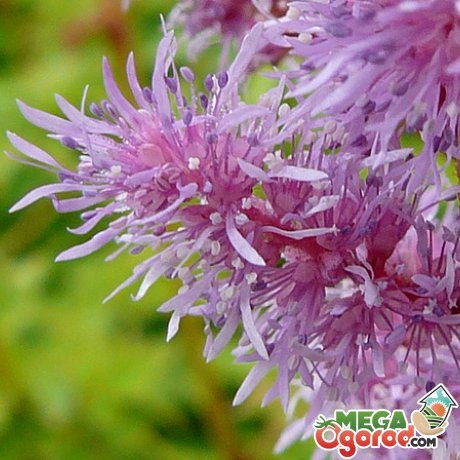

Let astilba and a perennial plant, but it still needs a transplant. Time passes, the roots look to the surface and begin to dry out. This condition of the plant is the main reason for not very good appearance and noticeably poor flowering. The flowers become smaller and the number of peduncles decreases.
Transplant astilbe every four years to keep it looking good.
With a sharp tool, divide the bush so that developed buds remain in each part, deepen them when planting three centimeters into the ground. Feed the young bushes with complex fertilizers or humus, water, after watering, mulch the pit with peat.
In the first year, all peduncles must be removed as they weaken the plant. You can transplant less often, provided that you constantly add fertile soil to the roots of the plant.
Planting astilba in open ground
The best period for planting astilba in gardens of temperate latitudes is May-month, when there is enough heat and moisture in the soil, although the plant takes root quite well after transplanting at any time of the growing season, even flowering, the main thing is to ensure regular watering for 15-20 days.
Growing conditions for astilbe
Herbaceous shrubs are planted in a semi-shady part of the garden on moderately fertile soil with a close occurrence of groundwater, because they are able to withstand even a short-term stagnation of moisture.
However, many varieties created by breeders are also adapted to open spaces, but, according to observations, they fade faster.
Early and late flowering varieties can also be planted in places where there is a lot of sun, but varieties that open their panicles in the middle of summer are more suitable only for a shaded place.
The soil for growing astilba is desirable fertile; on poor soils, in the absence of rainfall and watering, the plant dies.
Features of planting an astilba flower in the ground in spring
On flower beds, plants are planted at a distance of 30 cm, and for tall varieties, the pits for planting are separated from each other by 50 cm.
If seedlings are planted for growing in a temporary place, then transverse grooves are used every 20-30 cm on ridges 1 m wide.
A little, 25-30 grams, of mineral fertilizers, in which no more than 10% nitrogen, and a handful of ash or bone meal are poured into the dimples or on the beds with grooves, you can add a little humus.
The plants are buried so that the root collars are below the soil level, and watered, then mulch is poured around the seedlings or divisions in a layer 3 cm thick.
The use of astilba in landscape design and combination with other plants
Usually, astilba is planted with a small curtain against the background of shrubs or conifers, although in nature it grows among deciduous trees.


The traditional partners in the flowerbed of the plant are hosts, Siberian irises and ferns.
Astilbes are often grown in the company of primroses, swimsuits, gravilates, Iberis, and also in the vicinity of bells and berserk.
The main thing is that moisture-loving and shade-tolerant plants grow next to astilbe, with the rest there will be problems in care.
Low varieties are also planted in curbs, but rarely. The inflorescences are suitable for cutting, they are perfectly preserved in bouquets and do not lose their decorative effect for a long time.
Left on the bushes in the winter, they even decorate the garden with snow.
In one place, the plant can grow up to 20 years with proper care, but the renewal of the bushes is still desirable every 4-5 years, since the rhizome grows rather quickly, the young roots turn out to be above the soil level and dry out, affecting the duration of flowering.
Landing site selection and soil requirement
Remember, the culture doesn't like drafts and completely open spaces. It is undesirable to constantly hit the sun's rays on the flower.


It should not be forgotten that all types of plants love moist and light soil. Therefore, the place in your front garden and the soil should come first when growing a flower.
Fertilizing and feeding plants
Astilba is an unpretentious culture. But for the formation of the largest bush, powerful flowering, you must follow all the rules for growing it.
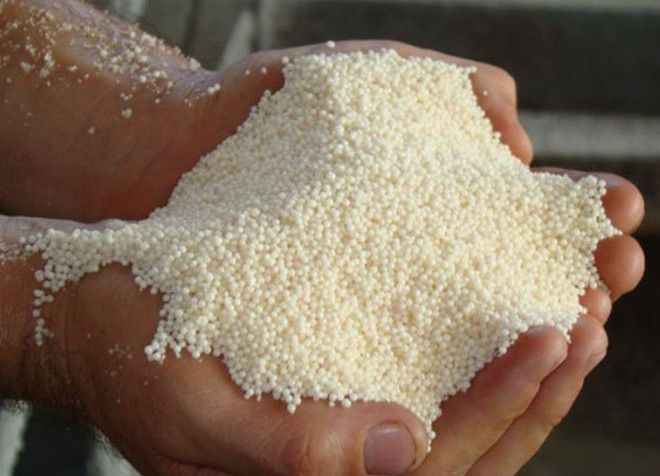

Flower feeding takes place in 3 stages:
- spring - the introduction of humus during hilling;
- mid-summer (flowering period). Fertilizers should contain a large percentage of potassium;
- autumn (end of flowering). They use phosphorus additives, organic and mineral preparations.
After feeding, the soil is loosened and mulched.
Stratification
Before sowing
astilba seeds need to be stratified - this is a prerequisite, otherwise you can not wait for seedlings. Start this procedure in February-March. We will describe one of the most famous stratification methods.
Prepare small container
with a substrate (peat with sand in a ratio of 1: 1), lay a layer of snow up to 1 cm thick on top (you can take it from the freezer). Spread the seeds over the surface without digging.
The snow will gradually melt, moisten the soil and immerse the seeds in it. Alternatively, mix the seeds with sand and sow in moist soil.
Please note that astilba seeds are very small and working with them is not easy
.
Cover crops
glass or film (you can just put the container in a plastic bag) and send it to the refrigerator for 21 days.It can be just any dry room with an air temperature from -4 to +4 degrees.
Sometimes, before the end of the stratification period, the seeds start to hatch
.
Growing seedlings
Further crops move
to a room with a temperature of 18-22 degrees, where very soon the entire surface of the substrate is torn with thin, like hairs, green sprouts.
Germination percentage
largely depends on the variety of astilba and the quality of the seed. Be careful with watering to avoid killing the seedlings. Water must be poured either at the root or by injection of a syringe into the soil.
When 1-2 true leaves appear
dive seedlings directly into the beds in the open ground. Choose a semi-shaded spot somewhere near high plantings, preferably on the north side of the house.
there is individual varieties
astilbe, which have adapted well to growing in the sun. They even bloom more abundantly, but much less in time.
It's great if there will be water nearby
- pool, artificial reservoir, fountain. The composition of the garden soil is preferable neutral - pH 5.5-6.5.
In the gardens of astilba often planted next to the hosts
: Large leaves of the hosta retain moisture and prevent the soil from overheating even in the most intense heat.
Garden design
Astilba is presented in an amazing variety of varieties. They differ in height, shape and color of inflorescences and foliage. When decorating the garden with shrubs, remember that in spring and autumn it will decorate the space with openwork of leaf plates, in summer - with lush flowers. We will acquaint you with the basic techniques of landscape design using astilbe.
- There is no need to cover the plant with other flowers, it is decorative and self-sufficient. Organize a shade garden of different heights. Place tall bushes on the background, dwarf on the front.
- Astilbe decorate the space around fruit trees, planting them in a circle.
- You can arrange flowers along an artificial reservoir, creating an original coastline.
- Landing along curbs is popular. For this purpose, choose varieties with dense inflorescences in the form of candles.
- If you want to combine the plant with other representatives of the flora, choose early-flowering bulbous varieties. After the crocuses daffodils and / or tulips have faded, the astilba will cover the "bare" place with its lush, spreading foliage.
- Perennials hosta and heycherella will be a good company for a flower. They will accentuate the spectacular look of her foliage. For the same purpose, some growers use ferns and conifers.
The shade-tolerant, unpretentious beauty astilba is able to decorate any forgotten corner, into which the sunbeam rarely looks. And planting in the central part of the garden will give it a unique, bright look. Be sure to find a place for a perennial in your personal plot and take care of it, according to the recommendations of our article.
Transplanting seedlings to a permanent place
For the emergence and normal growth of seedlings, an air temperature of + 18 + 22 ° C, good lighting without direct sunlight and a constantly damp ground are required. Special care must be taken when watering seedlings. The emerging green sprouts, similar to hairs, are best watered from a syringe or spray, trying not to break fragile seedlings. Seedlings, after the appearance of 2-3 true leaves, dive into small pots to plant on a site, in a balcony box or a decorative flowerpot.
Even a novice florist can handle the planting of astilba:
Astilba is planted in open ground in May-June, when the threat of return frosts has passed. Despite the fact that the roots of perennials endure severe frosts, delicate shoots can die from the cold.
Pests
All the parasites that could "take a liking" to astilbe remained in Asian countries. In middle latitude, only 2 pests can attack a flower.
Slobbering penny
It settles in the leaf sinuses. It can be detected by the foamy, slobbering secretions that the larvae belch. If the penny has settled on a flower, the foliage shrivels, becomes covered with yellow spots. They fight the parasite with the drugs Confidor, Rogor, Aktara.
Strawberry nematode
If this pest has settled on the plant, the leaf plates are deformed, painted brown. The growth of the bush slows down. If you find signs of infection, dig up and destroy the shrub so that the parasite does not spread to healthy flowers. For prophylaxis, treat the foliage with Fitoverm.
Selection Tips
Chinese Astilba is a beautiful herb, when choosing which it is worth considering some points. Due to the large number of varieties of this culture, the gardener will need to give preference to the one that will look harmonious on the site. When choosing an astilbe, you need to take into account its adult height. This type of plant can bloom at different times, so if you want to decorate the area at the beginning, middle or end of the summer period, you should take this moment into account.
An important indicator of the decorativeness of the Chinese perennial is the color of its blooming buds, which are white, pink, purple and others.


Autumn care and wintering
After the astilbe has faded, the flowers do not need to be plucked. They look decorative on the bush before the onset of cold weather. But they take moisture and nutrients from the plant. Therefore, it is better to leave only the peduncles from which the seed collection is planned.
Before wintering, the stems must be cut to the very surface of the earth. Sprinkle the area with mulch (spruce branches, sawdust, dry leaves). This is especially important for plants that have recently been planted as a result of division of the rhizome. Frost-resistant species can hibernate only under a layer of snow.
Astilba cultivation, care, reproduction.
This flower has taken root well in Siberia, and in all its variety of species. It tolerates our winters well, but in the spring, tender sprouts can freeze under recurrent frosts.
It is considered an unpretentious perennial, but it has its own characteristics. for example, planted in a sunny area will produce small inflorescences and even dry out. With a lack of moisture, the plant also feels discomfort and the tips of the inflorescences begin to wither and dry quickly.
In general, the bulk of astilba varieties prefer partial shade or slightly discharged light and moist soil. And if it is also fertile, then the flower will bloom especially magnificently and for a long time.


Although this plant always manages to look spectacular. For this, he is chosen to decorate the shady corners of their garden. You can plant several varieties, from very tiny, 15 cm high, to huge two meters. And then in the garden they will alternately replace others with their flowering.
The flower, as I said, is picky about moisture.With frequent droughts, the soil is mulched around its bushes so that moisture does not quickly evaporate. Otherwise, you will not get an openwork beauty, but an incomprehensible color and shape of a broom.
Astilba care.
The flower is really unpretentious in leaving. Once a year, you can feed it with a full complex fertilizer or compost. Diseases and pests do not affect it, at least in our region. once every 5 years, astilba needs to be transplanted. The old bush stops blooming and dries up.
Reproduction of astilba.
Usually it is propagated by dividing the bush. The roots of the flower are branchy, like ropes. They can be easily cut with a shovel. From one large bush, you can make several divisions and plant them.
With this planting, the pits make a little more rhizome, place the plant and sprinkle it with earth. In the first days after transplanting, daily watering is required until the plant takes root in a new place.
Astilba is also propagated by shoots. In the spring, a young shoot is cut off, the cut is processed and placed in a peat mixture in a greenhouse. So the plant lives until next spring, and then transplanted to a permanent place.
Hybrid forms and varieties
The pink herb has different hybrid forms, which differ from each other in the flowering period, the color of the buds, foliage, and the height of the stem. This perennial can have the following varieties according to the flowering time:
- early flowering, which blooms in the first days of summer;
- medium flowering, the flowering phase of which occurs in the middle of summer;
- late blooming, which bloom in August.


Dwarf
The most interesting dwarf varieties of Chinese astilba are considered to be the following.
- "Pumila". This plant differs from the rest in its growth and flower buds. An adult perennial can grow up to 40 centimeters. "Pumila" blooms with beautiful lilac-pink flowers. The culture perfectly tolerates low temperatures, surviving even at -28 degrees.


- "Vision in White"... The plant boasts a well-developed root system. This variety is presented in the form of a compact bush, in height does not exceed 0.45 m.When flowering on the culture, white dense inflorescences are formed. This representative of the flora does not require special care, prefers a shaded area for growth.
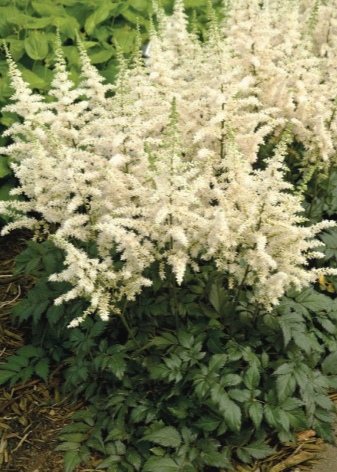

Medium-sized
In addition to dwarf varieties of Chinese astilba, gardeners often prefer medium-sized representatives of this culture. These include the following plants.
- Milk and Honey - the original variety of Chinese astilba, which has memorable external characteristics. This spreading and densely leafy bush can grow up to 100 cm in height in the shade, and in a well-lit area - no more than 0.7 m. The variety is characterized by the presence of brownish internodes. In an adult plant, the leaves have a spring green color and unusual edges. The jagged foliage is inherent in delicacy and originality. The culture begins to bloom in mid-July and ends at the end of summer. The buds appear to be a fluffy pearl white, but can later become pinkish. The aroma of Milk and Honey is subtle, sweetish. Perennial responds well to regular soil irrigation.
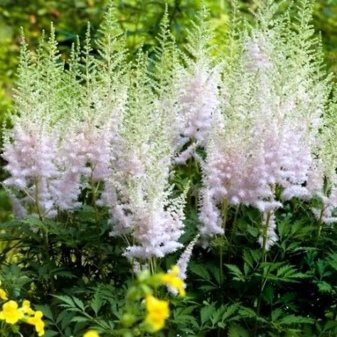

- "Purple Rhine" has large and powerful inflorescences about 0.3 meters long. The buds are bright pink with a lilac tint. The flowers of the culture are small and quite fragrant, their blooming occurs in the middle of summer. This variety is characterized by the abundance and duration of flowering. Chinese astilbe forms compact, pyramidal shrubs. The foliage of the perennial is shiny, dark green in color. The variety is classified as frost-resistant.
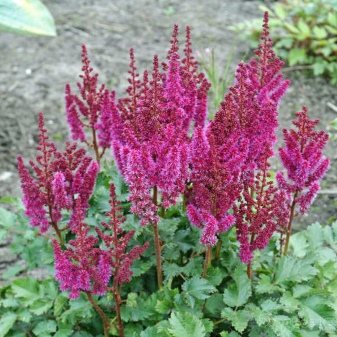

High
Such varieties are classified as tall Chinese astilbe.
- "Visions in red"... This herbaceous perennial grows up to 0.3 m in height and width. This Chinese astilbe is recognized as one of the most attractive in appearance. The culture has purple-red buds that are located on red shoots.The flowering period of Vision In Red is about a month. The variety is characterized by good frost resistance and unpretentious care.
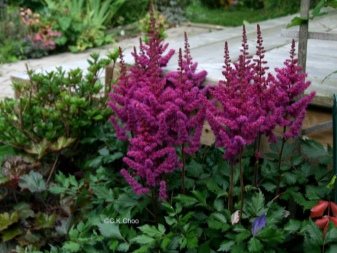

- "Purplekertse" - this is one of the highest astilbe. Its normal height is 0.9-1 meter. Perennial foliage is characterized by rigidity, rich green color, shine and a shade of bronze. The inflorescences of this plant variety have a lilac, violet, purple hue and a magnificent shape. The beginning of flowering of this culture is considered to be the end of July - the beginning of August, the phase lasts until the end of summer. Astilba is resistant to the sun, short-term drought.
Read also Izba reading room open my page


- Dauria - a bush that can reach a height of 100 centimeters. The foliage of the plant is complex, shiny, delicate. In the inflorescence there are small flowers with pink, lilac, white color. The beginning of flowering culture is considered June - early July, the end of the phase occurs in a month and a half.
An unpretentious perennial is good for partial shade and wet loamy soil. The variety is used for forcing, as well as cutting.
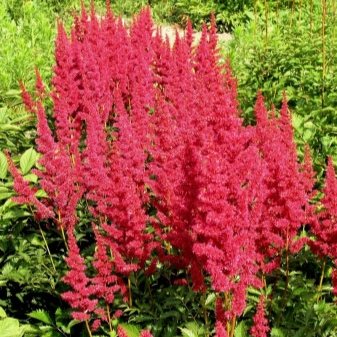

- "Superba" is a vigorous shrub with a height of 100 to 150 centimeters. With its shiny green attractive foliage and pink-lilac panicles, Astilba is awe-inspiring. The culture grows quickly, blooms profusely at the end of summer.
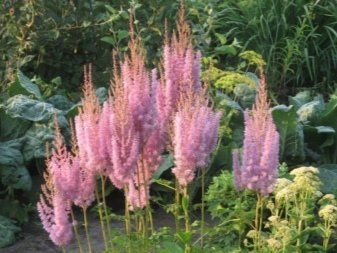

Sowing seeds for seedlings
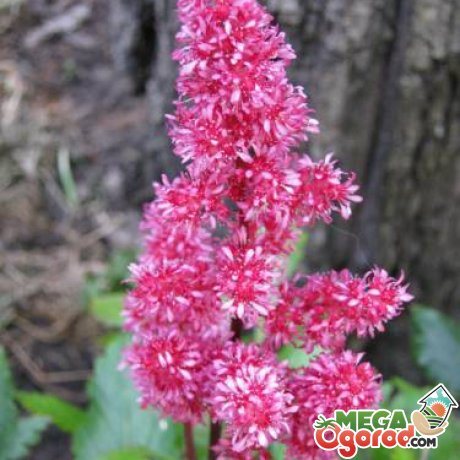

The seed of this flower must be stratified. You need to start doing this in February. In one month, you need to create conditions in the apartment close to natural, in which plant seeds winter. This procedure will greatly increase seed germination.
Mix peat and sand in equal parts in a wide container, and on top lay a thin layer (1 cm) of snow on which you want to put the seeds. The snow will melt and the seeds will start sinking into the moist ground. When the seeds are completely in the soil, place the container in a cool place. After three weeks, transfer the container to a lighted and warm place.
You can grow seedlings immediately after stratification.
The earth should not dry out, but it should not be too wet either. A spray bottle or a spray bottle will be the perfect tool for watering the sprouts. After the first shoots appear, carefully water them with a syringe under the root. Dive, pinching off one third of the root, seedling, after two real leaves appear. In late spring, more or less strong seedlings can be planted in the garden. It is better to plant in the shade.
Examples in landscape design
Astilba Chinese landscape designers are often used to decorate personal plots, since during flowering this plant has luxurious buds. The culture is in perfect harmony with other representatives of the flora on the territory, and can also advantageously complement the flower bouquet.
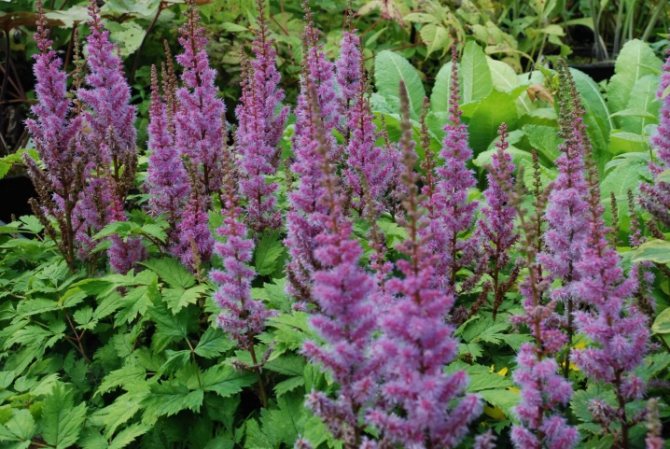

Previously, this bush could be seen exclusively on balconies and loggias, but today it is a full-fledged inhabitant of gardens and vegetable gardens.
A slender and long shoot of a perennial can turn a lawn, a flower garden or the shore of a reservoir into a real work of art. Iris, primrose and hosta go well with astilba. Low-growing varieties can be used in alpine slides.
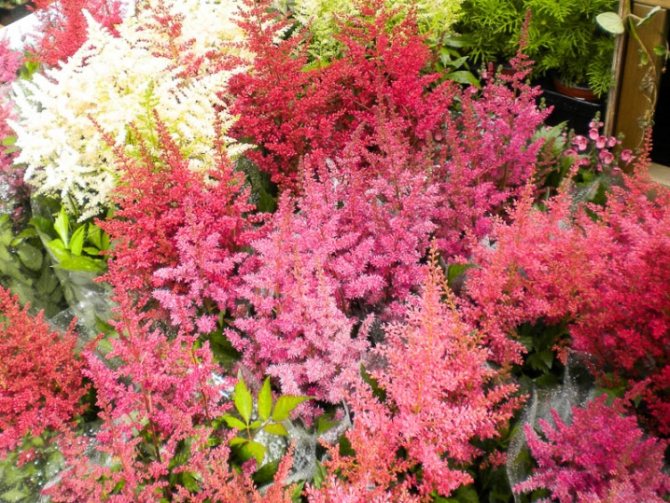

For information on how to properly care for Chinese Astilba, see the next video.
In every garden, except for Japanese, Chinese astilba must be grown. The explanation is simple. It is a late flowering perennial. This means that it will decorate the garden after the panicles of early flowering Japanese astilbe or some of Arends' hybrids have lost their decorative effect.
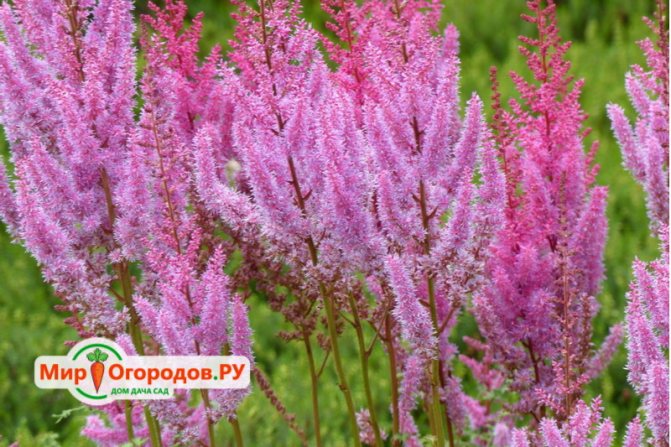

Growing and care
Astilbe is very attractive and easy to grow. Caring for astilba is simple.
Growing conditions
To enjoy their beauty all season, you need to provide the plants with the following conditions:
- shady or semi-shaded position;
- fertile, humus, permeable, constantly slightly moist soil;
- plants cannot stand the scorching sun and drought.
The position for growing astilba must be thought out, because plants planted in the wrong place quickly lose their decorative qualities and stop blooming.
Watering
The soil is constantly kept moist. The wetter the substrate, the less harmful the plant is from being in full sun.
Top dressing
Astilbe is demanding on nutrition, during the growing season they should be systematically fed, preferably with organic fertilizers (the flower does not really like mineral fertilizers). Organic matter not only provides basic nutrients to the plant, but also improves the structure of the soil, increases the amount of humus in the soil.
From the second year of cultivation, until the growth of shoots, well-fermented manure or peat-compost soil is distributed between the plants.
Wintering
Astilbe is quite resistant to winter temperatures, does not require winter shelter. However, spring frosts can be dangerous for them, therefore, before the announced drop in temperature, the plants are covered with non-woven material or needles.
Spring care
In early spring, during the first harvest in the garden, the dead aerial parts of the plant left over from the last season are removed. This will give young shoots an easier path to growth. In the spring, you can divide old bushes into smaller ones and move them to another location.
Read also Apple tree belongs to flowering plants
After about 3 years, a significant decrease in flowering intensity can be noticed. At this time, it is worth digging up the plants again, dividing and replanting.


Flowering acceleration
In order for astilba to bloom earlier, the following technique is used. The bushes are prepared in early autumn to speed up flowering. A plant with a rhizome containing at least 6 clearly visible buds is planted in pots with a diameter of 17-20 cm and stored at a temperature of 0-1.5 ° C, immersed in moist peat. With the onset of frost, the plants are additionally protected with peat, leaves and spruce branches.
They begin to stimulate the growing season in February. The temperature in the initial period of acceleration should be 10-12 ° C, after the leaves appear, it is raised to 15-18 ° C, and the greenhouses are shaded.
The bushes are only watered, not fertilized!
Plants transferred to the greenhouse in February will bloom in 10-12 weeks, waking up in late April - May, after 3-4 weeks.
Removing inflorescences
Pruning off faded flowers is also a good idea to extend the flowering time. Seed formation should not be allowed to prolong flowering.

